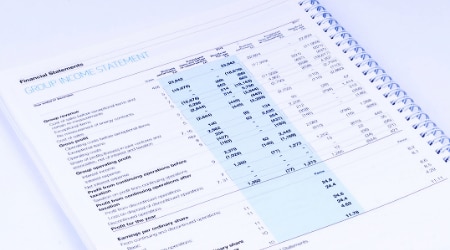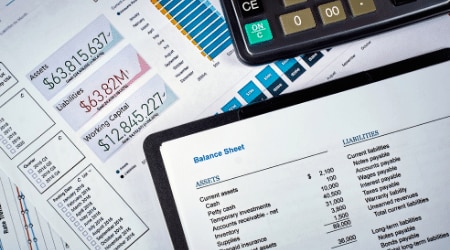In this article, you will learn:

Understanding Accounts Receivable
- What Is Accounts Receivable?
- What Kind of Account Is Accounts Receivable?
- What Are Accounts Receivable Examples?
- What Is the Journal Entry for Accounts Receivable?
- Accounts Payable Vs Accounts Receivable
- Accounts Receivable Turnover Formula
- Net Accounts Receivable
- Net Realizable Value of Accounts Receivable
Typically, you as a business usually sell goods on credit to your customers. That is, you deliver goods or render services now, send the invoice, and get paid for them at a later date.
Now, you record the money that your customers owe to you as Accounts Receivable in your books of accounts.
Accounts Receivables are one of the important current assets of your business. Typically, you sell goods or services on credit to attract customers and augment your sales.
Likewise, extending trade credit is helpful to your customers for it gives them time to pay for goods or services they purchase on credit.
However, there is an element of risk attached to accounts receivable. That is, you are yet to receive cash against such credit sales. Therefore, it is important that you manage your accounts receivable carefully.
In this article, we will learn what is accounts receivable, accounts receivable examples, and accounts payable vs accounts receivable.
What Is Accounts Receivable?
Accounts Receivable refers to the amount that your customers owe to you for the goods or services sold to them on credit. Such credit sales are also known as trade receivables or extending trade credit to your customers.
In other words, you provide goods and services to your customers instantly. However, you receive payments for such goods and services after a few days.
The customers to whom you sell goods or services on credit are recorded as trade debtors or accounts receivable in your books of accounts. That is, you record accounts receivable in general ledger accounts under the account titled ‘Accounts Receivable’ or ‘Trade Debtors’.
So, the question that comes to mind is as follows: ‘Is Accounts Receivable an Asset’? Yes, because this is the outstanding balance that you are yet to receive from your customers. Accordingly, such unpaid balance in the accounts receivable account forms part of the current assets on your company’s balance sheet.
Risk of Bad Debts
As a seller, you must be careful in extending trade credit to your customers. This is because there is a risk of non-payment attached to accounts receivables. The customers who may not pay for the goods sold to them are recorded as bad debts in the books of accounts.
Typically, businesses sell goods on credit only to creditworthy customers. Still, good accounting practice requires you to keep some amount for accounts receivable that may not be paid.
This amount is recorded in the provision for doubtful accounts. Thus, the Bad Debts Expense Account gets debited and the Allowance for Doubtful Accounts gets credited whenever you provide for bad debts.
So, the Allowance for doubtful accounts helps you to understand how much amount you need to collect from your debtors. In other words, the credit balance in the Allowance for doubtful accounts tells you the amount that is doubtful to be collected from your credit customers.
What Kind of Account Is Accounts Receivable?
Does this section answer the question ‘Is Accounts Receivable an Asset’? Yes! As stated above, Accounts Receivable is an asset account recorded as current assets on your company’s balance sheet.
It is nothing but the amount that your customers owe to you in a short period of time for the goods or services they receive on credit.
Accounts receivable is recorded as the current asset on your balance sheet. This is because you are liable to receive cash against such receivables in less than one year.
However, if such a receivable takes more than one year to convert into cash, it is recorded as a long-term asset on your company’s balance sheet.
Further, as mentioned earlier, there is a risk of non-payment attached to some of your accounts receivable. Therefore, as per the Accrual Accounting System, your Accounts Receivable account is reduced by the amount set aside as Allowance for Doubtful Accounts.
The Allowance for Doubtful Accounts tells you about the estimated amount of bad debts associated with specific accounts receivable.
So, the following balance sheet of XYZ Enterprises shows accounts receivable as on the year ending December 31, 2019.
| Assets | Amount | Liabilities | Amount |
| Current Assets | Current Liabilities | ||
| Cash | $200,000 | Accounts Payable | $60,000 |
| Accounts Receivable | $80,000 | Notes Payable | $25,000 |
| Inventory | $25,000 | Accrued Expenses | $14,800 |
| Prepaid Expenses | $10,000 | Deferred Revenue | $5,000 |
| Investments | $20,000 | ||
| Total Current Assets | $335,000 | Total Current Liabilities | $104,800 |
| Property & Equipment | Long Term Debt | $330,000 | |
| Land | $30,000 | ||
| Building | $300,000 | Total Liabilities | $434,800 |
| Equipment | $50,000 | ||
| (-) Accumulated Depreciation | $5,000 | Shareholder’s Equity | |
| Total Property & Equipment | $375,000 | Common Stock | $50,000 |
| Additional Paid-In Capital | $30,000 | ||
| Other Assets | Retained Earnings | $200,000 | |
| Intangible Assets | $5,000 | Total Shareholder’s Equity | $280,000 |
| (-) Accumulated Amortization | $200 | ||
| Total Other Assets | $4,800 | ||
| Total Assets | $714,800 | Total Liabilities | $714,800 |
What Are Accounts Receivable Examples?
Let’s understand what is Accounts Receivable via an example. Lewis Publishers requires 10,000 tons of paper for publishing books at the rate of $20 per ton.
Now, Lewis Publishers purchases this quantity of paper on credit from Ace Paper Mill. In such a case, Ace Paper Mill invoices Lewis for $200,000 (10,000 tons x $20 per ton) and gives Lewis Publishers a Credit Period of 45 days to pay the amount.
Now, till the time Ace Paper Mill does not receive cash $200,000, it will record $200,000 as Accounts Receivable in its books of accounts. Thus, both accounts receivable and sales account would increase by $200,000.
When Lewis Publishers makes the payment of $200,000, Ace Paper Mill will increase the Cash Account by $200,000 and reduce Debtors or Accounts Receivable Account by $200,000.
It can also be the case that Lewis Publishers does not make the payment within 45 days. In such a case, Ace Paper Mill would either reach out to Lewis Publishers for payment or hire a collection agency for collecting Accounts Receivable.
What Is the Journal Entry for Accounts Receivable?
Let’s consider the above example again to understand what is accounts receivable and the journal entry for accounts receivable.
1. When Goods Are Sold On Credit
As per the above example, Ace Paper Mill sold worth $200,000 paper to Lewis Publishers on a 45-day period credit. The journal entry at the time the invoice is raised would be as follows:
| Accounts Receivable A/c Dr | $200,000 |
| To Sales | $200,000 |
Thus, debiting Accounts Receivable with $200,000 means an increase in Accounts Receivable by the same amount.
Likewise, crediting the Sales Account by $200,000 means an increase in Sales by the same amount.
2. When Cash Is Received For Goods Sold On Credit
In the above example, Lewis Publishers $200,000 in cash to Ace Paper Mill within 45 days. The journal entry at the time cash is received for goods sold on credit would be as follows:
| Cash A/c Dr | $200,000 |
| To Accounts Receivable | $200,000 |
As per the above journal entry, debiting the Cash Account by $200,000 means an increase in Cash Account by the same amount.
Likewise, crediting Accounts Receivable by $200,000 means a decrease in the Accounts Receivable by the same amount.
Accounts Payable Vs Accounts Receivable
What is Accounts Receivable?
As a business owner, you undertake numerous transactions on credit. That is, you purchase as well as sell goods on credit. When you sell goods on credit, your customers owe money to you. That is, you act as a creditor to your customers. Such a credit sale is recorded as accounts receivable in your books of accounts.
What is Accounts Payable?
However, there are times when you purchase goods on credit from your suppliers. In, such cases, your suppliers act as your creditors. Thus, such a credit purchase is recorded as Accounts Payable in your books of accounts.
Now, let’s have a look at the differences between accounts receivable and accounts payable.
| S.No. | Basis | Accounts Payable | Accounts Receivable |
| 1. | Definition | Accounts payable is the amount you owe to any third-party for the goods or services received from them. Such a third-party could be a bank, a company, a private lender, etc. | Accounts receivable is the amount that your customers owe to you for the goods or services delivered to them on credit. |
| 2. | Recording in Books of Accounts | Purchasing goods on credit would result in the purchases account being debited and the accounts payable account being credited. This means an increase in credit purchases and an increase in accounts payable. | Selling goods on credit would result in the accounts receivable account being debited and the sales account being credited. This means an increase in both accounts receivable and sales account. |
| 3. | Type of Account | Accounts Payables are recorded as current liabilities. | Accounts Receivables are recorded as current assets. |
| 4. | Offset | Accounts Payables have no offsetting account. | On the other hand, Accounts Receivables are offset by Allowance for Doubtful Accounts. |
| 5. | Discounts | If you purchase goods on credit from your vendor, he may offer you a discount on such purchases. Such a discount is given so that you may pay the amount earlier to your vendor. Further, this discount is represented as x/15 or n/30. x/15 is read as x% discount that you will receive if you make payment within 15 days. Likewise, n/30 is read as the net amount that you will pay to your vendor within 30 days. | If you sell goods on credit from your customer, you may offer a discount on such sales. Such a discount is given so that your customer makes early payments. Further, this discount is represented as x/15 or n/30. x/15 is read as an x% discount that you will offer if your customer makes payment within 15 days. Likewise, n/30 is read as the net amount that you will receive from your customer within 30 days. |
| 6. | Example | Lewis Publishers purchased $200,000 worth of paper from Ace Paper Mills on credit. The terms of such a purchase were 1/10, n/30. Therefore, Lewis Publishers will record this purchase transaction in the following manner:
| Ace Paper Mills sold $200,000 worth of paper to Lewis Publishers on credit. The terms of such a sale were 1/10, n/30. Therefore, Ace Paper Mills will record this sale transaction in the following manner:
|
Accounts Receivable Turnover Formula
Accounts receivable turnover measures how efficiently your business collects revenues from customers to whom goods are sold on credit. The Accounts Receivable Turnover is also known as Debtors Turnover.
Further, it also measures how efficiently you as a business use your assets. Thus, Accounts Receivable Turnover is a ratio that measures the number of times your business collects its average accounts receivable over a specific period.
Accordingly, the Accounts Turnover Ratio Formula is as follows:
Accounts Receivable Turnover = Net Credit Sales/Average Accounts Receivable
What Are Net Credit Sales?
Net Credit Sales include the value of goods sold on credit for which payment is received at a later date.
Accordingly, Net Credit Sales is calculated by using the Net Credit Sales Formula.
Net Credit Sales = Credit Sales – Sales Returns – Sale Allowances
What is Average Accounts Receivable?
Average Accounts Receivable are nothing but the average of opening and closing accounts receivable over a period of time. That is, it is calculated as follows:
Average Accounts Receivable = (Opening Accounts Receivable + Closing Accounts Receivable)/2
Accounts Receivable Turnover Ratio Example
To augment sales, Ace Paper Mill sells paper on credit to its customers. The details as of December 31, 2019, are as follows:
| Particulars | Amounts |
| Gross Credit Sales | $200,000 |
| Sales Return | $30,000 |
| Opening Accounts Receivable | $20,000 |
| Closing Accounts Receivable | $40,000 |
Accounts Receivable Turnover (in Times)
Accordingly, the number of times Ace Paper Mill will collect Average Accounts Receivable over the year would be as follows:
Accounts Receivable Turnover Ratio = Net Credit Sales/Average Accounts Receivable
= ($200,000 – $30,000)/(($20,000 + $40,000/2))
= $170,000/$30,000 = 5.66 times
Thus, Ace Paper Mill will collect its average accounts receivables close to 5.66 times over the year ending December 31, 2019.
Accounts Receivable Turnover (in Days)
Accounts Receivable Turnover in days represents the average number of days your customer takes to make payment against goods sold on credit to him.
Accordingly, Accounts Receivable Turnover in days is calculated using the following formula:
Accounts Receivable Turnover in days = 365/Receivable Turnover Ratio
As per the above example, the Accounts Receivable Turnover Ratio in days for Ace Paper Mills would be 365/5.66 times. That is, 64.48 Days.
According to the above example, a customer on an average takes 65 days to pay for the goods purchased on credit for Ace Paper Mills.
Say, Ace Paper Mills has a credit policy of 45 days. It extends credit to its customers for a period of 45 days. If that is the case, Ace Paper Mills is receiving late payments from its customers.
Net Accounts Receivable
Net Accounts Receivable is the total amount that your customers are liable to pay less the money that is doubtful to be collected from such customers.
Thus, Net Accounts Receivable are used to measure the effectiveness of your business’ collection process from customers to whom goods are sold on credit.
Further, goods sold on credit have a risk of non-payment attached to them. Thus, bigger the difference between Gross Receivables and Net Receivables, bigger the issue with your business’ trade credit and collection policy.
The management makes an estimate in respect of the amount of accounts receivable that will never be collected from the customers. Such an estimate is recorded as allowance for doubtful accounts and is used to offset accounts receivable.
What is Allowance For Doubtful Accounts?
The Allowance For Doubtful Accounts is nothing but the estimate of accounts receivable not expected to be paid by the customers for goods sold on credit to them.
Such an allowance offsets the accounts receivable. That is, you subtract the allowance of doubtful accounts from accounts receivable. This is done to calculate the net amount of accounts receivable anticipated to be collected by your business.
As per Accrual System of Accounting, you record Allowance for Doubtful Accounts so that you get an understanding of the amount of bad debts that can occur in future.
This brings accuracy to your financial statements. Furthermore, the Allowance for Doubtful Accounts is recorded as a Contra Account with Accounts Receivable on your company’s balance sheet.
Net Accounts Receivable Formula
The Net Accounts Receivable Formula is as follows:
Net Accounts Receivables = Gross Receivables – Allowance for Doubtful Accounts
Net Accounts Receivable Example
Say, Ace Paper Mills has 2 million dollars Gross Receivables. Furthermore, it has an allowance for Doubtful Accounts of $70,000. Therefore,
Net Receivables = $2,000,000 – $70,000
= $1,930,000
Furthermore, these receivables are also expressed in terms of percentage. Accordingly,
Net Receivables (in %) = Net Receivables/Gross Receivables
= $1,930,000/$2,000,000 = 96.5%
Net Realizable Value of Accounts Receivable
Net Realizable Value of Accounts Receivable is nothing but the amount that is anticipated to be collected by the company from its customers. That is, the amount of accounts receivables expected to be converted into cash.
Typically, you as a business owner sell goods on credit to your customers. Now, extending trade credit to your customers has a default risk attached to it. In other words, there may be certain customers who may not pay cash for the goods purchased on credit from you.
So, you need to set aside some amount of money as an allowance for doubtful accounts. Such an allowance is subtracted from the Gross Receivables of your business to determine the Net Realizable Value of Accounts Receivables.
Accordingly, Net Realizable Value of Accounts Receivable is a measure of valuing the accounts receivables of your business.
Net Realizable Value of Accounts Receivable Formula
The formula for Net Realizable Value of Accounts Receivable is as follows:
Net Realizable Value of Accounts Receivable = Gross Receivables – Allowance for Doubtful Accounts












